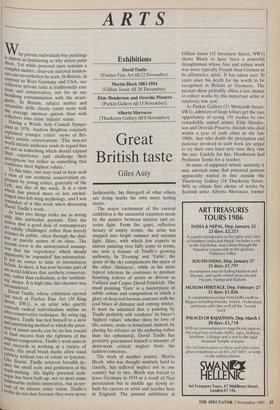ARTS
Why private individuals buy paintings is almost as fascinating as why artists paint them. Yet while personal taste remains a complex 'Vex matter, clear-cut national tenden- cies can nevertheless be seen. In Britain, in contrast to West Germany and USA, our collective private taste is traditionally cau- tious and conservative; not for us any headlong consummation with the avant- garde. In Britain, subject matter and ostensible skills clearly count more with the average amateur patron than with collectors who claim 'initiate' status.
During a Welsh Arts Council Sympo- sium in 1978, Andrew Brighton concisely explained younger critics' views of Bri- tain's artistic conservatism: 'This non-art world initiate audience tends to regard fine an not as something which should expand their experience and challenge their Perceptions but rather as something that reinforces their highest values.'
To this time, one may read or hear such a view of our aesthetic conservatism ex- pressed by young critics, generally of the Left, any day of the week. It is a view Which has passed more or less unchal- lenged into left-wing mythology, and I was reminded of it this week when discussing David Tindle's work. At least two things strike me as wrong with this particular premise. First the notion that a good deal of contemporary art validly 'challenges' rather than merely :irritates its public, often through the shal- low or puerile nature of its ideas. The 'cond error is the unwarranted assump- tion that the 'experience' which should apparently be 'expanded' has automatical- ly led its owner to false or inconclusive beliefs. In short, it has now become part of _art-world folklore that aesthetic conservat- 'tn, rather than radicalism, is the 'unthink- ing' choice. It is high time this chestnut was reconsidered. i David Tindle, whose exhibition opened last week at Fischer Fine Art (30 King `greet, SW1), is an artist who quietly conceals radical individualism within an ultra-conservative technique. By using egg tempera, Tindle has tied himself to a slow and painstaking method in which the preci- sion of minor marks can be no less crucial
,
`° final success than the rightness of the original composition. Tindle's work aims at and succeeds in working at a variety of levels. His small brush marks allow tonal subtlety without loss of colour or lyricism. Like Seurat, Tindle achieves breadth de- spite the small scale and gentleness of his Inark-making. His highly personal tech- nique has been built up, not to meet some fashionable stylistic imperative, but as ser- vant of an intense inner vision. Tindle's Works do not date because they were never
Exhibitions
David Tindle
(Fischer Fine Art till 22 November)
Alberto Morrocco
(Thackeray Gallery till 8 November)
Great British taste
Giles Auty
fashionable; his disregard of what others are doing marks his own more lasting status.
The major excitement of the current exhibition is the successful transition made by the painter between interior and ex- terior light. From the quiet, reflective beauty of empty rooms, the artist has stepped into bright summer and autumn light. Skies, with which few experts in indoor painting ever fully come to terms, are now a feature of Tindle's growing authority. In `Evening' and 'Table', the space of the sky complements the space of the other 'distances', while in his more typical interiors he continues to produce haunting echoes of artists as diverse as Vuillard and Caspar David Friedrich. The small painting 'Gate' is a masterpiece of subtle colour and composition in which a glory of deep red-browns contrasts with the cool blues of distance and coming winter. It must be admitted that a painting by Tindle probably will 'reinforce' its buyer's `highest values' whether these be love of life, nature, order or homeland. Indeed, by placing his reliance on the enduring rather than the ephemeral, David Tindle has probably guaranteed himself a measure of short-term critical neglect from the fashion-conscious.
The work of another painter, Martin Bloch, who was thought similarly hard to classify, has suffered neglect not in one country but in two. Bloch was forced to leave Germany in 1934 as a result of Nazi persecution but in middle age slowly re- built his careers as artist and teacher here in England. The present exhibition at Gillian Jason (42 Inverness Street, NW1) shows Bloch to have been a powerful draughtsman whose free and robust work was more typically French than German in its affirmative spirit. It has taken over 30 years since his death for his worth to be recognised in Britain or Germany. The present show probably offers a last chance to collect works by this important artist at relatively low cost.
At Parkin Gallery (11 Motcomb Street, SW1), admirers of large felines get the rare opportunity of seeing 150 studies by two remarkable animal artists: Elsie Hender- son and Orovida Pissarro, friends who died within a year of each other in the late 1960s. Any who doubt the perception and patience involved in such work are urged to try their own hand next time they visit the zoo. Luckily for her, Henderson had Professor Tonks for a teacher.
In times of supposed artistic austerity it may astonish some that potential patrons apparently waited in line outside the Thackeray Gallery (18 Thackeray Street, W8) to obtain first choice of works by Scottish artist Alberto Morrocco, former Head of Painting at Dundee Art College. Cheerfulness and lack of inhibition are major features of this artist's work, which is widely represented in Scottish museums. This last suggests that alternative means of artistic success do exist to that of endlessly belabouring or trying to shock the bourgeoisie — who might turn out to be useful and discerning patrons, given half a chance.























































 Previous page
Previous page